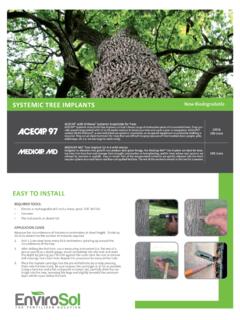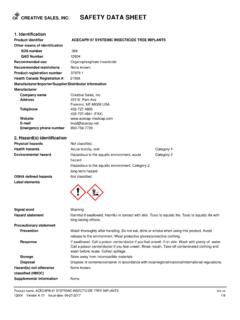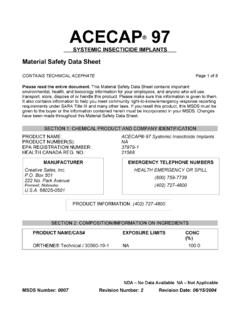Transcription of Homeowner Guide to Emerald Ash Borer ert Insecticide ...
1 Homeowner Guide to Emerald Ash Borer Insecticide Treatments R. Chris Williamson and PJ Liesch, UW Entomology Emerald ash Borer Insecticide treatment considerations. Several Insecticide products are available to homeowners for control of Emerald ash Borer (EAB). However, not all ash trees are worth treating with insecticides. Tree location, value, and health, as well as the cost of treatment are all factors to consider. Based on current research, treatments are suggested only for ash trees located within 15 miles of a confirmed EAB site, or for trees located within a quarantined area. Insecticide treatments are not necessary for ash trees located outside of these areas. Even within the 15 mile radius, not all trees should be treated. Due to the expense of yearly Insecticide treatments, one should consider the value of a particular ash tree in relation to Insecticide treatment costs before making any treatments.
2 In addition, consider the health of each tree before treating. Research suggests that Insecticide treatments are significantly more effective on EAB-infested ash trees with less than 50% canopy thinning. Insecticide treatments are not suggested for trees with greater than 50% canopy thinning. Trees with greater than 50% canopy thinning should be removed and destroyed in accordance with established guidelines. For a more detailed discussion on this topic, see University of Wisconsin Garden Facts XHT1215, Is My Ash Tree Worth Treating for Emerald Ash Borer . Emerald ash Borer Insecticide treatment options. Insecticide products available for use by homeowners are summarized in Table 1. They include: acecap 97 systemic Insecticide Tree implants (acephate) Amdro Tree & Shrub Care Concentrate (imidacloprid) Bayer Advanced Tree and Shrub Insect Control II (imidacloprid) Bayer Advanced Tree and Shrub Protect & Feed (imidacloprid) Bayer Advanced Tree and Shrub Protect & Feed II (imidacloprid + clothianidin) Compare N Save systemic Tree & Shrub Insect Drench (imidacloprid) Ferti-lome Tree and Shrub systemic Drench (imidacloprid) Monterey Once a Year Insect Control II (imidacloprid) Optrol (imidacloprid) Ortho Bug-B-Gone Year Long Tree & Shrub Insect Control (imidacloprid) Most of the products available to homeowners are systemic insecticides containing imidacloprid and are applied as soil drenches around the base of an ash tree.
3 A few granular products are also available. Recent university research suggests that spring applications of imidacloprid may be most effective. Research also indicates that soil applications of imidacloprid provide excellent EAB protection in the first year following treatment for small ash trees that are less than about 18 inches in circumference. Larger trees may require two years of treatment before they are effectively protected. Thus, treatment of a large tree should begin before the tree becomes infested. Lastly, Insecticide treatments must be repeated each year. Be aware that many Insecticide products available at hardware stores and garden centers look alike. Carefully check all product labels before purchase to make sure that you have selected the correct product/active ingredient. ALWAYS read and follow the pesticide label directions on the product that you select!
4 Finally, note that although acecap 97 systemic Insecticide Tree implants are available to homeowners, we do NOT recommend that homeowners use these because they require physically drilling into a tree during their application. University of Wisconsin Pest Alert Provided to you by: XHT1181 Revised March 25, 2014 Table 1 Emerald ash Borer Insecticide treatments available to homeowners Product Active Ingredient Timing Type of application Amdro Tree & Shrub Care Concentrate (D) Bayer Advanced Tree & Shrub Insect Control II (D) Bayer Advanced Tree & Shrub Protect & Feed (D or G) Compare N Save systemic Tree & Shrub systemic Insect Drench (D) Ferti-lome Tree & Shrub systemic Drench (D) Monterey Once a Year Insect Control II (D) Ortho Bug B Gone year Long Tree & Shrub Insect Control (D) Imidacloprid Mid-April to mid-May Soil Drench (D) or Granular (G) Optrol (D) Imidacloprid Mid-April to mid-May and/or Early-Sept.
5 To mid-Oct. Soil drench (D) Bayer Advanced Garden Tree & Shrub Protect & Feed II (D or G) Imidacloprid + Clothianidin Mid-April to mid-May Soil Drench (D) or Granular (G) acecap 97 systemic Insecticide Tree implants Acephate Mid-May to mid-June Trunk Implant Other Emerald ash Borer treatment options. Homeowners may also contact a certified arborist or certified pesticide applicator to treat their trees. See for a list of certified arborists in Wisconsin. Professionals have access to some products that are not available to homeowners. The University of Wisconsin does not endorse commercially available Insecticide products over those available directly to homeowners. Products discussed in this fact sheet have been evaluated in Michigan State University research tests on EAB. 2008-2014 by the Board of Regents of the University of Wisconsin System doing business as the division of Cooperative Extension of the University of Wisconsin Extension.
6 An EEO/Affirmative Action employer, University of Wisconsin Extension provides equal opportunities in employment and programming, including Title IX and ADA requirements. This document can be provided in an alternative format by calling Brian Hudelson at (608) 262-2863 (711 for Wisconsin Relay). References to pesticide products in this publication are for your convenience and are not an endorsement or criticism of one product over similar products. You are responsible for using pesticides according to the manufacturer s current label directions. Follow directions exactly to protect the environment and people from pesticide exposure. Failure to do so violates the law. Thanks to Kristin Krokowski, Phil Pellitteri and Robert Tomesh for reviewing this document. A complete inventory of University of Wisconsin Garden Facts is available at the University of Wisconsin-Extension Horticulture website: For more information on controlling Emerald ash Borer : See , or or contact your county Extension agent.
7 For a video demonstration of treating your ash trees using a systemic drench, see University of Wisconsin Pest Alert









